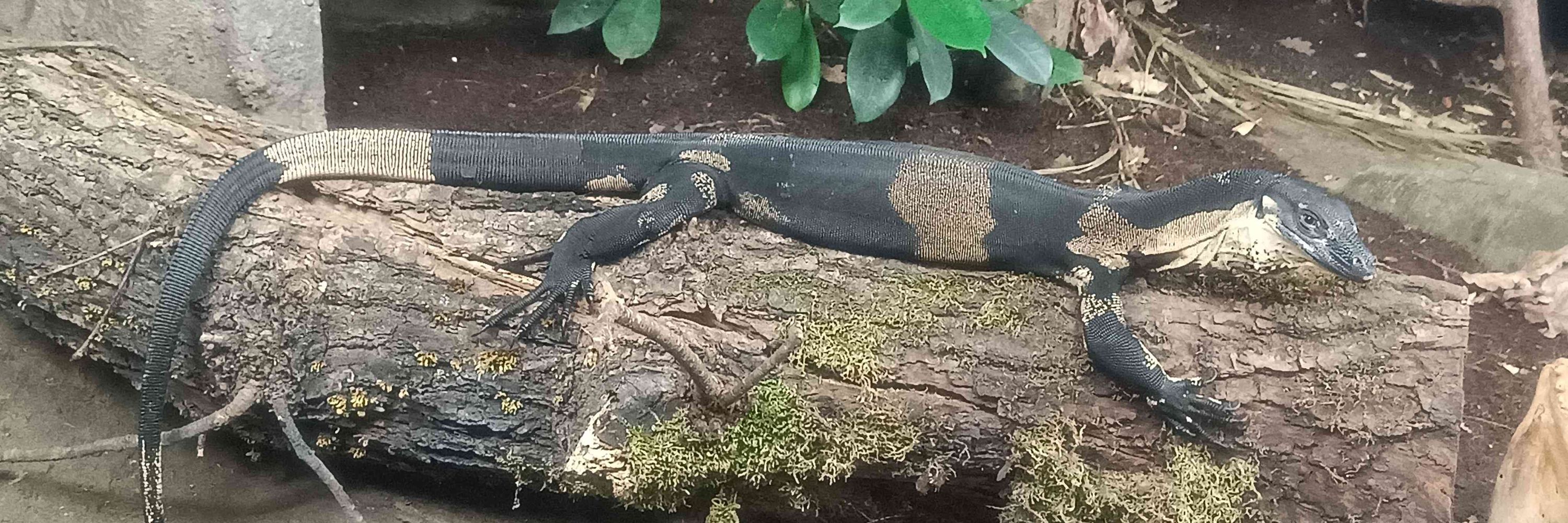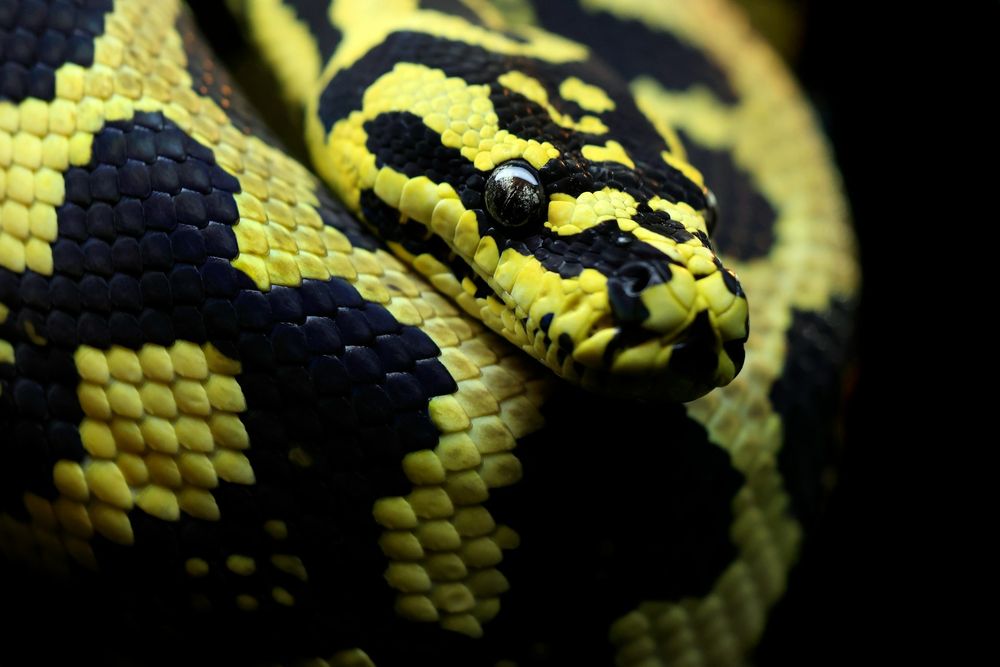
The monitor lizard in my banner is a Varanus varius in Copenhagen Zoo.
Max size for males 150 cm (4'11"), for females 91 cm (3').
Omnivorous.
Found in Argentina, Bolivia, Brazil, Paraguay and Uruguay.
Used for bushmeat and in the leather trade.
Considered Least Concern by the IUCN.
📷by evandroanjos on Pixabay

Max size for males 150 cm (4'11"), for females 91 cm (3').
Omnivorous.
Found in Argentina, Bolivia, Brazil, Paraguay and Uruguay.
Used for bushmeat and in the leather trade.
Considered Least Concern by the IUCN.
📷by evandroanjos on Pixabay
This subspecies has a max. size of ~2.6 m (~8'6"), but is usually smaller. Females tend to be larger than males.
Found in rainforests in northeastern Queensland, Australia.
📷by david-clode-unsplash

This subspecies has a max. size of ~2.6 m (~8'6"), but is usually smaller. Females tend to be larger than males.
Found in rainforests in northeastern Queensland, Australia.
📷by david-clode-unsplash
Max. size for males 62 mm (2.4"), for females 76 mm (3").
Found in forested areas of Thailand, Peninsular Malaysia and on the island of Sumatra in Indonesia.
Considered Least Concern by the IUCN.
📷by kuritafsheen77 on Freepik

Max. size for males 62 mm (2.4"), for females 76 mm (3").
Found in forested areas of Thailand, Peninsular Malaysia and on the island of Sumatra in Indonesia.
Considered Least Concern by the IUCN.
📷by kuritafsheen77 on Freepik
Max. length 37 cm (14.6"), 2/3 of which is the tail.
Found from Iran and Afghanistan in the west to the Philippines in the east. It has been introduced in many places around the world.
Considered Least Concern by the IUCN.
📷by Erik_Karits on Pixabay.

Max. length 37 cm (14.6"), 2/3 of which is the tail.
Found from Iran and Afghanistan in the west to the Philippines in the east. It has been introduced in many places around the world.
Considered Least Concern by the IUCN.
📷by Erik_Karits on Pixabay.
Max size 155 cm (5'1").
Ambush predator. At 5 cm (2") it has the longest fangs of any snake.
Found in forested areas and grasslands in large parts of Sub-Saharan Africa.
Considered Vulnerable by the IUCN.
📷byConnor Padraic Mallon, Smithsonian's National Zoo

Max size 155 cm (5'1").
Ambush predator. At 5 cm (2") it has the longest fangs of any snake.
Found in forested areas and grasslands in large parts of Sub-Saharan Africa.
Considered Vulnerable by the IUCN.
📷byConnor Padraic Mallon, Smithsonian's National Zoo
Max. size 64 mm (2.5"). Females tend to be larger than males.
Found in the US from Texas in the west, through Florida in the southeast and as far northeast as New Jersey.
Considered Least Concern by the IUCN.
📷by Brett_Honslow on Pixabay

Max. size 64 mm (2.5"). Females tend to be larger than males.
Found in the US from Texas in the west, through Florida in the southeast and as far northeast as New Jersey.
Considered Least Concern by the IUCN.
📷by Brett_Honslow on Pixabay
Max. size 20.3 cm (8"), Males tend to be slightly larger than females.
Found in the southeastern USA. Has been introduced around the Pacific, in the Caribbean, in Mexico and in California.
Considered Least concern by the IUCN.
📷by Ray_Shrewsberry on Pixabay

Max. size 20.3 cm (8"), Males tend to be slightly larger than females.
Found in the southeastern USA. Has been introduced around the Pacific, in the Caribbean, in Mexico and in California.
Considered Least concern by the IUCN.
📷by Ray_Shrewsberry on Pixabay
Max size more than 200 cm (6'6.7").
Found in northern and central China, Korea, eastern Mongolia and eastern Russia.
Considered Least Concern by the IUCN.
📷by plesnercph

Max size more than 200 cm (6'6.7").
Found in northern and central China, Korea, eastern Mongolia and eastern Russia.
Considered Least Concern by the IUCN.
📷by plesnercph
Max size males ~4 cm (~1.6"), females ~4.5 cm (~1.8").
Females may physically fight over a calling male.
Found in southern Suriname and across the border with Brazil.
Not evaluated by the IUCN.
📷by William Warby on Pexels

Max size males ~4 cm (~1.6"), females ~4.5 cm (~1.8").
Females may physically fight over a calling male.
Found in southern Suriname and across the border with Brazil.
Not evaluated by the IUCN.
📷by William Warby on Pexels
May be part of a species complex of closely related species difficult to tell apart.
Max. size ~38 cm (~15").
Found in in eastern, central and southern Africa.
Considered Least Concern by the IUCN.
📷Lisa Stockton on Unsplash

May be part of a species complex of closely related species difficult to tell apart.
Max. size ~38 cm (~15").
Found in in eastern, central and southern Africa.
Considered Least Concern by the IUCN.
📷Lisa Stockton on Unsplash
Max. size 104 cm (3'5").
Found from France and the UK in the west, across Scandinavia, Central Europe, Russia, Ukraine and all the way to north-western China and Mongolia.
Considered Least Concern by the IUCN.
📷by wirestock on Freepik

Max. size 104 cm (3'5").
Found from France and the UK in the west, across Scandinavia, Central Europe, Russia, Ukraine and all the way to north-western China and Mongolia.
Considered Least Concern by the IUCN.
📷by wirestock on Freepik
Max carapace length over 50 cm (~19.7").
Omnivore, but eats mostly fruit, flowers and leaves.
Found on some Caribbean islands and from Panama to northern Argentina.
Not evaluated by the IUCN.
📷 by Bergheimatfilm on Pixabay

Max carapace length over 50 cm (~19.7").
Omnivore, but eats mostly fruit, flowers and leaves.
Found on some Caribbean islands and from Panama to northern Argentina.
Not evaluated by the IUCN.
📷 by Bergheimatfilm on Pixabay
Max. size 14 cm (5.5").
Largest tree frog species in the world.
Found in northern Queensland, Papua New Guinea and on surrounding islands.
Considered Least Concern by the IUCN.
📷by David Clode on Unsplash

Max. size 14 cm (5.5").
Largest tree frog species in the world.
Found in northern Queensland, Papua New Guinea and on surrounding islands.
Considered Least Concern by the IUCN.
📷by David Clode on Unsplash
Max. size 90 cm (3 feet), but usually smaller.
Found in drier areas in Portugal, Spain, southern France and North-western Italy.
Eats snails, larger insects and (occasionally) fruit.
Considered Near Threatened by the IUCN.
📷by wirestock on Freepik

Max. size 90 cm (3 feet), but usually smaller.
Found in drier areas in Portugal, Spain, southern France and North-western Italy.
Eats snails, larger insects and (occasionally) fruit.
Considered Near Threatened by the IUCN.
📷by wirestock on Freepik
Max length ~2m (~6'7"). Females tend to be larger than males.
Eats rodents and reptiles.
Found in and around New Guinea and in Cape York, Australia.
Considered Least Concern by the IUCN.
📷by kuritafsheen77 on Freepik

Max length ~2m (~6'7"). Females tend to be larger than males.
Eats rodents and reptiles.
Found in and around New Guinea and in Cape York, Australia.
Considered Least Concern by the IUCN.
📷by kuritafsheen77 on Freepik
Max. size 43 mm (1.7").
Can change colours from white to dark brown.
Found in most of Australia except for the southernmost parts, in southern Papua New Guinea and on the island of Timor.
Considered Least Concern by the IUCN.
📷by kuritafsheen77 on Freepik

Max. size 43 mm (1.7").
Can change colours from white to dark brown.
Found in most of Australia except for the southernmost parts, in southern Papua New Guinea and on the island of Timor.
Considered Least Concern by the IUCN.
📷by kuritafsheen77 on Freepik
Max size for males 60 cm (23.6"), for females 50 cm (19.7).
Found in New South Wales, Queensland, South Australia and Victoria (Australia).
Considered Least Concern by the IUCN.
📷by MemoryCatcher on Pixabay

Max size for males 60 cm (23.6"), for females 50 cm (19.7).
Found in New South Wales, Queensland, South Australia and Victoria (Australia).
Considered Least Concern by the IUCN.
📷by MemoryCatcher on Pixabay
Max. size 240 cm (7'10").
Non-venomous.
Arboreal.
Eats birds, bats and lizards. In captivity they usually also eat rodents.
Found pretty much all over South East Asia.
Considered Least Concern by the IUCN.
📷by Pixel-mixer on Pixabay

Max. size 240 cm (7'10").
Non-venomous.
Arboreal.
Eats birds, bats and lizards. In captivity they usually also eat rodents.
Found pretty much all over South East Asia.
Considered Least Concern by the IUCN.
📷by Pixel-mixer on Pixabay
Max size 160 mm (6.3").
Found in France, Portugal and Spain.
Threatened by habitat loss and collection for the pet trade.
Considered Vulnerable by the IUCN.
📷from Pixnio

Max size 160 mm (6.3").
Found in France, Portugal and Spain.
Threatened by habitat loss and collection for the pet trade.
Considered Vulnerable by the IUCN.
📷from Pixnio
Max. size ~29cm (~11.4").
Found in Southeast Asia in Laos, Malaysia, Myanmar, Singapore, Thailand, Vietnam, on the islands of Bali, Borneo, Java, Sumatra, Andaman and the Nicobar Islands.
Considered Least Concern by the IUCN.
📷by kuritafsheen77 on Freepik

Max. size ~29cm (~11.4").
Found in Southeast Asia in Laos, Malaysia, Myanmar, Singapore, Thailand, Vietnam, on the islands of Bali, Borneo, Java, Sumatra, Andaman and the Nicobar Islands.
Considered Least Concern by the IUCN.
📷by kuritafsheen77 on Freepik
Max size 180 cm (5'10.9").
Venomous.
Found in Mexico.
Not evaluated by the IUCN.
📷by Miguel Angel Padrinan Alba on Unsplash

Max size 180 cm (5'10.9").
Venomous.
Found in Mexico.
Not evaluated by the IUCN.
📷by Miguel Angel Padrinan Alba on Unsplash
My recipe is also in the Alt-text. I use the immersion blender below, which is one of the best things I've ever bought for my kitchen (picture included so I have somewhere to put the recipe).

My recipe is also in the Alt-text. I use the immersion blender below, which is one of the best things I've ever bought for my kitchen (picture included so I have somewhere to put the recipe).
Max. size for males 44 mm (1.7"), for females 60 mm (2.4").
Found in tropical rainforests in Bolivia, Brazil, Colombia, Ecuador, the Guianas, Peru and Venezuela.
Considered Least Concern by the IUCN.
📷by bloederr on Pixabay

Max. size for males 44 mm (1.7"), for females 60 mm (2.4").
Found in tropical rainforests in Bolivia, Brazil, Colombia, Ecuador, the Guianas, Peru and Venezuela.
Considered Least Concern by the IUCN.
📷by bloederr on Pixabay
Max. size 40 cm (15.7"), but usually smaller. Males tend to be larger than females.
Found in forested areas in two tiny areas of Tanzania.
Considered Near Threatened by the IUCN.
📷by kuritafsheen77 on Freepik

Max. size 40 cm (15.7"), but usually smaller. Males tend to be larger than females.
Found in forested areas in two tiny areas of Tanzania.
Considered Near Threatened by the IUCN.
📷by kuritafsheen77 on Freepik
Max size 225 cm (7'4.6").
This is the species seen in many symbols for the medical profession.
Non-venomous.
Found From France and Spain in the west to Azerbaijan and Iran in the east.
Considered Least Concern by the IUCN.
📷by Noverodus on Pixabay

Max size 225 cm (7'4.6").
This is the species seen in many symbols for the medical profession.
Non-venomous.
Found From France and Spain in the west to Azerbaijan and Iran in the east.
Considered Least Concern by the IUCN.
📷by Noverodus on Pixabay

